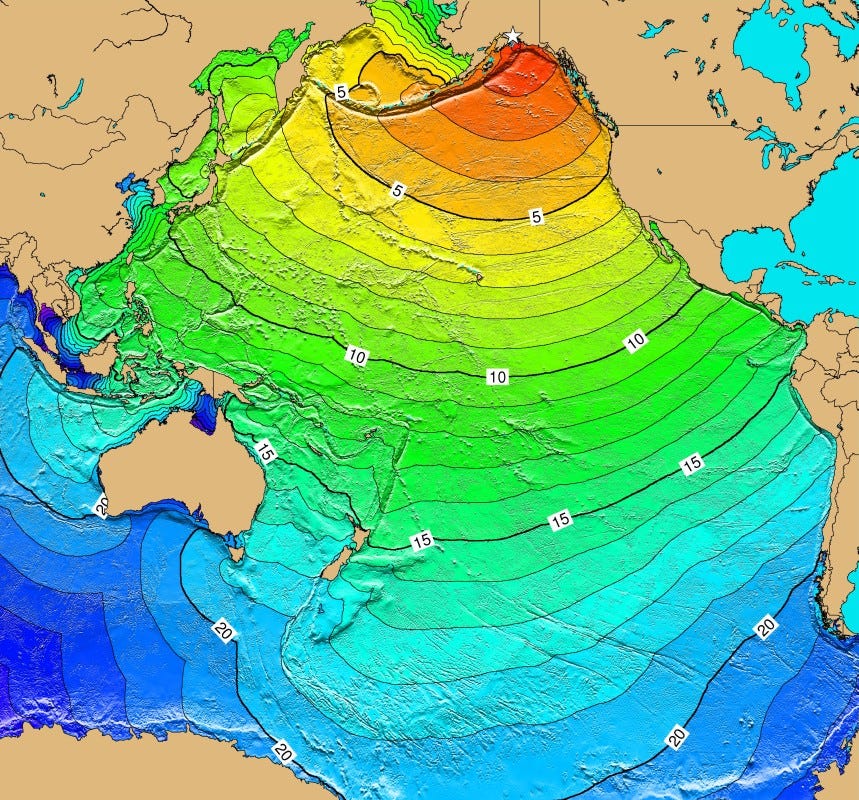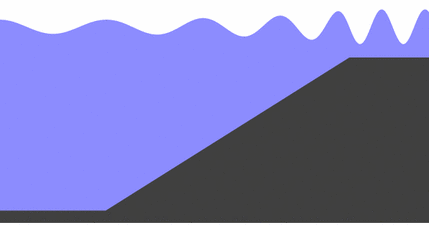What makes tsunamis different from the waves we surf?
The word tsunami literally means "harbor wave" in Japanese, which tells you something about where these waves become most dangerous. But calling both tsunamis and the waves we surf "waves" is like calling both a freight train and a skateboard "vehicles" - technically correct, but completely different beasts.
Regular waves, the surface gravity waves that we tend to dabble in, are born from wind. As we've covered before, wind drags across the ocean surface, transferring energy into the water through friction. This creates waves that typically have wavelengths of 100-200 meters and periods of 10-20 seconds. The energy penetrates down to about half the wavelength, so a typical swell only involves the top 50-100 meters of ocean.
Tsunamis are not wind driven. When tectonic plates suddenly shift during an earthquake, or when a massive landslide displaces water, the entire water column moves - from surface to seafloor. Where a regular wave might involve moving a swimming pool's worth of water per meter of wave crest, a tsunami moves an entire building's worth.

This difference in generation leads to radically different wave characteristics. A tsunami's wavelength can stretch 100-500 kilometers - that's roughly the distance from San Diego to Los Angeles. With wavelengths this massive, even the deep ocean acts like shallow water to a tsunami. Waves "feel" the bottom when water depth is less than about half their wavelength. For tsunamis, this means they're always in contact with the seafloor, even crossing the deepest ocean trenches.
While our typical surfable waves cruise along at 20-40 mph in deep water, tsunamis cross oceans at jet speeds. The shallow water wave speed equation tells us that velocity equals the square root of gravity times depth. In 4,000 meters of water, roughly the average depth of the Pacific, that works out to about 450 mph.
In deep water, a tsunami might raise the sea surface by only a meter or less. Ships at sea often don't even notice them passing underneath. The wavelength is so long that the slope is incredibly gentle - imagine a hill in Kansas that rises 3 feet over 60 miles. You wouldn't notice you were climbing it.

This subtle surface expression masks enormous energy. When tsunamis reach shallow water, the same shoaling process that makes our waves steepen applies here, but with catastrophic results. As the tsunami slows from 450 mph to perhaps 30 mph near shore, conservation of energy demands that all that kinetic energy transforms into something else. The wave compresses horizontally and grows vertically. That gentle meter-high swell in deep water can tower 10-30 meters at the coast.
Unlike a breaking wave that's mostly foam and turbulence lasting seconds, a tsunami is a sustained wall of water backed by the momentum of the entire ocean. Surface waves involve circular particle motion that decreases with depth - below the wave base, water barely moves. But tsunamis move the entire water column horizontally. When a 10-meter storm wave crashes on shore, it's spectacular but brief. When a 10-meter tsunami arrives, it's a relentless surge that continues for minutes, grinding inland with the weight of the Pacific behind it.
The difference in water volume explains why you can duck dive a 15-foot wave but a 15-foot tsunami can level entire cities. One is a surface phenomenon playing out in the top layer of the ocean; the other is the entire ocean beaching itself.
For all those who flock to the water to see the tsunami - don't. At best with a small one, you won't see anything. At worst, it's catastrophically dangerous. Listen to officials on this one.
Further Reading:


Great explanation.